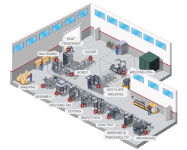Leak testing is a key quality control measure that ensures parts and assemblies meet their operational requirements. In the automotive sector, it verifies the safety and reliability of components and their production processes. Automotive component performance is critical, and vehicle manufacturers must choose suitable leak-testing methods to avoid safety issues, product recalls, warranty claims, and customer complaints.
What Is Leak Testing?
Leak testing is the quality control process that checks for liquid or gas leaks in manufactured parts. It’s a non-destructive testing method, as the tests won’t damage or alter the object under inspection. Leak testing encompasses various detection methods, giving you multiple options to choose from depending on the specific component or assembly you’re evaluating.
Also, the testing process ensures more than just product quality. By checking for leaks during production, you can also identify and address any problems within the manufacturing process itself that might be leading to quality issues. The testing process helps improve production efficiency and reliability, leads to quality end products, and reduces waste and rework.
Why Leak Testing Is Critical for Automotive Component Manufacturing and Assembly
The automotive sector is among the primary industries that rely on leak testing. Vehicles are made up of complex systems containing different types of fluids, some under pressure, that are very close to components that can be damaged if even a very small leak is present. EVs in particular require strict testing requirements as they have components like batteries and motors that can pose a danger to passengers if damaged.
Leaks within a single part affect the performance and safety of vehicles. At best, leaking parts will significantly impact the performance of your vehicle, reduce fuel efficiency, and increase emissions. At worst, a leaky component can prove disastrous, resulting in complete system shutdown, battery fires, and hazardous situations for drivers.
Differences Between EV and Internal Combustion Engine Leak Testing
EV designs don’t include a number of the components that vehicles with internal combustion engines have, like fuel lines and injection systems. In EVs, your focus for leak detection is on break fluids, water tanks, and AC fluids as such leaks will lead to damage in EV batteries.
Manufacturers will sometimes test their components to three times their maximum rated pressure to ensure nothing has the possibility to leak under even the most demanding operating conditions. Using tested, high-quality parts helps prevent short circuits as well as car fires and explosions, as EVs are extremely sensitive to leaks compared to internal combustion engine systems.
What Auto Components Require Leak Testing?
To ensure leak-tight parts and system or assembly connections, automakers employ leak testing for the following:
- Chassis and Powertrains: This automotive component category encompasses anything from transmission systems and engine blocks to wheels and drive axles. It also covers powertrain oil and water circuits, as well as electrical components like vehicle lights and electronic control components.
- Safety Components: Parts like airbag ignitors, brake lines, and fluid reservoirs all require leak testing to ensure optimal safety in a vehicle’s performance.
- Cooling Devices: Heat exchangers, radiators, AC hoses, condensers, and compressors should all undergo leak testing to ensure proper functionality.
- Batteries: A lithium-ion battery is an example of an EV component that benefits from leak testing.
- Fuel Systems: Systems like injection systems and fuel vapor management systems should receive leak testing, as should components like fuel lines, filters, pumps, and tanks.
- Completed Assemblies: In addition to the above systems and components, some final circuits that require leak testing include engine water and e-battery cooling circuits.
Other components that benefit from leak testing include but are not limited to water tanks, internal combustion motor parts, shock absorbers, headlights, and other automotive parts exposed to rain and humidity.
What Leak Test Methods Are Common in Automotive Component Assembly?
Different testing techniques are available to accommodate the wide array of components that require testing. They determine if a component has a leak and if its seal will hold at a predetermined pressure level. Some common leak test methods include:
- Helium Leak Test: This highly accurate test pressurizes a component with helium, which acts as the tracer gas, and then a sniffer probe scans for leaks. It’s effective at finding even small leakages.
- Pressure Decay Leak Detection: In the open air, pressure decay testing seals a component’s openings prior to pressurizing it inside. After stabilizing, you then monitor the internal pressure to detect decay.
- Vacuum Decay Leak Detection: Alternatively, a vacuum decay test monitors for pressure buildup occurring after lowering pressure levels and introducing a test medium.
- Flow Test: By bringing the air within the tested volume to constant pressure, you can identify that there’s a leak in a part should you need to add additional air to maintain pressure.
- Ultrasonic Testing: This inspection technique utilizes sound waves to indicate that a leak exists as well as pinpoint its location
Automated Leak Testing Solutions From AMD
Leaks, no matter how small, can significantly affect the reliability, effectiveness, and safety of an automotive component. At Advanced Manufacturing Development (AMD), we offer a range of automotive testing solutions. Based on your specific application, our team will assist you in selecting the optimal automated testing station and equipment as well as the right testing technique to assure optimal performance and quality in your products. Contact our team for more information, or request a quote today.

